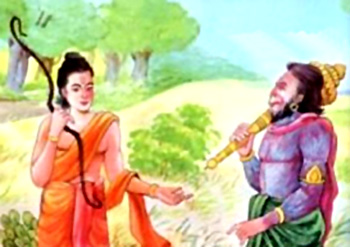 Alliance of Rama with Sugriva proved to be a fruitful friendship both Rama and Sugriva in their personal endeavour. Rama, after getting to know from a rakshasa while searching for Sita that the great monkey Sugriva lives in the Rishyamuka Mountain and he needs to meet him for Sugriva was a very good and gentle being who would help him in finding his wife Sita. Thus, Rama and Lakshmana moved towards the Rishyamuka Mountain and finding the two strangers Sugriva went to a secluded place and send Hanuman in the disguise of a hermit to know the intention of the two new human beings. When Hanuman came to know every thing in details from Lakshmana, he took them to Sugriva and introduced them to the monkey chief.
Alliance of Rama with Sugriva proved to be a fruitful friendship both Rama and Sugriva in their personal endeavour. Rama, after getting to know from a rakshasa while searching for Sita that the great monkey Sugriva lives in the Rishyamuka Mountain and he needs to meet him for Sugriva was a very good and gentle being who would help him in finding his wife Sita. Thus, Rama and Lakshmana moved towards the Rishyamuka Mountain and finding the two strangers Sugriva went to a secluded place and send Hanuman in the disguise of a hermit to know the intention of the two new human beings. When Hanuman came to know every thing in details from Lakshmana, he took them to Sugriva and introduced them to the monkey chief.
Rama and Sugriva held discussions with each other while Hanuman made fire by rubbing two pieces of wood, and passing sun wise about it, Rama and Sugriva were sworn in as friends, and they promised to help each other. Then Sugriva told his story and prayed Rama to help him, and he engaged himself to defeat the monkey-chief`s brother, and in return Sugriva promised to recover Sita. He informed Rama how he had seen her carried away by Ravana, and how Sita had dropped her veil and jewels, and he presented the tokens to Rama and Lakshmana.
After hearing the tale of Sugriva`s misfortune, Rama fared with Sugriva to Bali`s city, and overcame Bali, and put Sugriva on the throne of Kishkindha. After that, four months of the rainy season passed away, and when the skies grew clear and the floods diminished, Sugriva ordered his marshals to summon the monkey host. They came from Himalaya and Kailas and Vindhya, from the east and from the west, from near and far, from forests and caves, in hundreds and thousands and millions, and each host was led by a veteran leader. All the monkeys in the world assembled with joined hands in front of Sugriva. Then Sugriva presented them to Rama for his service, but Rama thought it best that Sugriva should issue all commands, since he was aware of such a host, and was suitably-informed with the matter to be accomplished.
Search for Sita
Since Rama, Lakshmana or Sugriva were not aware of the dwellings of Ravana except his name, Sugriva thus dispatched his entire host under leaders to search the four quarters for a month, as far as the uttermost bound of any land where men or demons dwelt, or sun shone. He however trusted as much in Hanuman as in all that host together, since Hanuman possessed tremendous energy and swiftness and vehemence and power of access to every place in earth or sky, and he was brave and politic and keen of wit and well aware of conduct befitting the time and place. And much as Sugriva depended on Hanuman, Hanuman was even more confident of his own power. Lord Rama also put his trust in Hanuman, and provided him his signet-ring to show for a sign to Sita when he should discover her.
Lord Hanuman then bowed to the feet of Rama, and left with the host appointed to search the southern quarter, while Rama waited for a month with Sugriva expecting his return. After a month the hosts returned from searching the north and east and west, sorry and dejected that they had not found Sita. But the southern host searched all the woods and caves and hidden places, till at last they came to the mighty ocean, the home of Varuna, boundless, resounding, filled with dreadful waves. A month had passed and Sita was not found; thus the monkeys sat dejected, looking at the sea and waiting for their end, for they dared not return to Sugriva. While waiting there they talked among themselves about Rama and Lakshmana and about Sita and regarding Jatayu, the vulture which fought till his death against Ravana to rescue Sita. There dwelt a mighty and very aged vulture named Sampati in a neighbouring cave, and he, hearing the monkeys talking of his brother Jatayu, came forth and asked about the same. Then the monkeys told him the whole affair, and Sampati answered that he had seen Sita carried away by Ravana and that Ravana dwelt in Lanka, a hundred leagues across the sea. Thus, the monkeys got to know that Sita was in Lanka, the kingdom of the demon king Ravana.



















